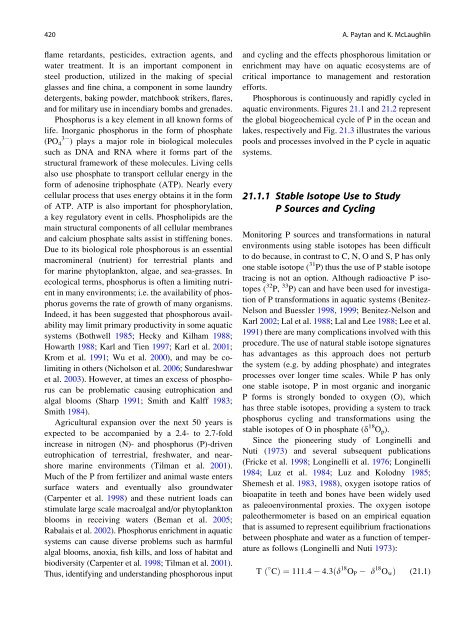Chapter 21. Adina Paytan. Tracing the Sources and Biogeochemical Cycling of Phosphorus in Aquatic Systems Using Isotopes of Oxygen in Phosphate
You also want an ePaper? Increase the reach of your titles
YUMPU automatically turns print PDFs into web optimized ePapers that Google loves.
420 A. <strong>Paytan</strong> <strong>and</strong> K. McLaughl<strong>in</strong><br />
flame retardants, pesticides, extraction agents, <strong>and</strong><br />
water treatment. It is an important component <strong>in</strong><br />
steel production, utilized <strong>in</strong> <strong>the</strong> mak<strong>in</strong>g <strong>of</strong> special<br />
glasses <strong>and</strong> f<strong>in</strong>e ch<strong>in</strong>a, a component <strong>in</strong> some laundry<br />
detergents, bak<strong>in</strong>g powder, matchbook strikers, flares,<br />
<strong>and</strong> for military use <strong>in</strong> <strong>in</strong>cendiary bombs <strong>and</strong> grenades.<br />
<strong>Phosphorus</strong> is a key element <strong>in</strong> all known forms <strong>of</strong><br />
life. Inorganic phosphorus <strong>in</strong> <strong>the</strong> form <strong>of</strong> phosphate<br />
(PO 3<br />
4 ) plays a major role <strong>in</strong> biological molecules<br />
such as DNA <strong>and</strong> RNA where it forms part <strong>of</strong> <strong>the</strong><br />
structural framework <strong>of</strong> <strong>the</strong>se molecules. Liv<strong>in</strong>g cells<br />
also use phosphate to transport cellular energy <strong>in</strong> <strong>the</strong><br />
form <strong>of</strong> adenos<strong>in</strong>e triphosphate (ATP). Nearly every<br />
cellular process that uses energy obta<strong>in</strong>s it <strong>in</strong> <strong>the</strong> form<br />
<strong>of</strong> ATP. ATP is also important for phosphorylation,<br />
a key regulatory event <strong>in</strong> cells. Phospholipids are <strong>the</strong><br />
ma<strong>in</strong> structural components <strong>of</strong> all cellular membranes<br />
<strong>and</strong> calcium phosphate salts assist <strong>in</strong> stiffen<strong>in</strong>g bones.<br />
Due to its biological role phosphorous is an essential<br />
macrom<strong>in</strong>eral (nutrient) for terrestrial plants <strong>and</strong><br />
for mar<strong>in</strong>e phytoplankton, algae, <strong>and</strong> sea-grasses. In<br />
ecological terms, phosphorus is <strong>of</strong>ten a limit<strong>in</strong>g nutrient<br />
<strong>in</strong> many environments; i.e. <strong>the</strong> availability <strong>of</strong> phosphorus<br />
governs <strong>the</strong> rate <strong>of</strong> growth <strong>of</strong> many organisms.<br />
Indeed, it has been suggested that phosphorous availability<br />
may limit primary productivity <strong>in</strong> some aquatic<br />
systems (Bothwell 1985; Hecky <strong>and</strong> Kilham 1988;<br />
Howarth 1988; Karl <strong>and</strong> Tien 1997; Karl et al. 2001;<br />
Krom et al. 1991; Wuetal.2000), <strong>and</strong> may be colimit<strong>in</strong>g<br />
<strong>in</strong> o<strong>the</strong>rs (Nicholson et al. 2006; Sundareshwar<br />
et al. 2003). However, at times an excess <strong>of</strong> phosphorus<br />
can be problematic caus<strong>in</strong>g eutrophication <strong>and</strong><br />
algal blooms (Sharp 1991; Smith <strong>and</strong> Kalff 1983;<br />
Smith 1984).<br />
Agricultural expansion over <strong>the</strong> next 50 years is<br />
expected to be accompanied by a 2.4- to 2.7-fold<br />
<strong>in</strong>crease <strong>in</strong> nitrogen (N)- <strong>and</strong> phosphorus (P)-driven<br />
eutrophication <strong>of</strong> terrestrial, freshwater, <strong>and</strong> nearshore<br />
mar<strong>in</strong>e environments (Tilman et al. 2001).<br />
Much <strong>of</strong> <strong>the</strong> P from fertilizer <strong>and</strong> animal waste enters<br />
surface waters <strong>and</strong> eventually also groundwater<br />
(Carpenter et al. 1998) <strong>and</strong> <strong>the</strong>se nutrient loads can<br />
stimulate large scale macroalgal <strong>and</strong>/or phytoplankton<br />
blooms <strong>in</strong> receiv<strong>in</strong>g waters (Beman et al. 2005;<br />
Rabalais et al. 2002). <strong>Phosphorus</strong> enrichment <strong>in</strong> aquatic<br />
systems can cause diverse problems such as harmful<br />
algal blooms, anoxia, fish kills, <strong>and</strong> loss <strong>of</strong> habitat <strong>and</strong><br />
biodiversity (Carpenter et al. 1998;Tilmanetal.2001).<br />
Thus, identify<strong>in</strong>g <strong>and</strong> underst<strong>and</strong><strong>in</strong>g phosphorous <strong>in</strong>put<br />
<strong>and</strong> cycl<strong>in</strong>g <strong>and</strong> <strong>the</strong> effects phosphorous limitation or<br />
enrichment may have on aquatic ecosystems are <strong>of</strong><br />
critical importance to management <strong>and</strong> restoration<br />
efforts.<br />
Phosphorous is cont<strong>in</strong>uously <strong>and</strong> rapidly cycled <strong>in</strong><br />
aquatic environments. Figures <strong>21.</strong>1 <strong>and</strong> <strong>21.</strong>2 represent<br />
<strong>the</strong> global biogeochemical cycle <strong>of</strong> P <strong>in</strong> <strong>the</strong> ocean <strong>and</strong><br />
lakes, respectively <strong>and</strong> Fig. <strong>21.</strong>3 illustrates <strong>the</strong> various<br />
pools <strong>and</strong> processes <strong>in</strong>volved <strong>in</strong> <strong>the</strong> P cycle <strong>in</strong> aquatic<br />
systems.<br />
<strong>21.</strong>1.1 Stable Isotope Use to Study<br />
P <strong>Sources</strong> <strong>and</strong> <strong>Cycl<strong>in</strong>g</strong><br />
Monitor<strong>in</strong>g P sources <strong>and</strong> transformations <strong>in</strong> natural<br />
environments us<strong>in</strong>g stable isotopes has been difficult<br />
to do because, <strong>in</strong> contrast to C, N, O <strong>and</strong> S, P has only<br />
one stable isotope ( 31 P) thus <strong>the</strong> use <strong>of</strong> P stable isotope<br />
trac<strong>in</strong>g is not an option. Although radioactive P isotopes<br />
( 32 P, 33 P) can <strong>and</strong> have been used for <strong>in</strong>vestigation<br />
<strong>of</strong> P transformations <strong>in</strong> aquatic systems (Benitez-<br />
Nelson <strong>and</strong> Buessler 1998, 1999; Benitez-Nelson <strong>and</strong><br />
Karl 2002; Lal et al. 1988; Lal <strong>and</strong> Lee 1988; Lee et al.<br />
1991) <strong>the</strong>re are many complications <strong>in</strong>volved with this<br />
procedure. The use <strong>of</strong> natural stable isotope signatures<br />
has advantages as this approach does not perturb<br />
<strong>the</strong> system (e.g. by add<strong>in</strong>g phosphate) <strong>and</strong> <strong>in</strong>tegrates<br />
processes over longer time scales. While P has only<br />
one stable isotope, P <strong>in</strong> most organic <strong>and</strong> <strong>in</strong>organic<br />
P forms is strongly bonded to oxygen (O), which<br />
has three stable isotopes, provid<strong>in</strong>g a system to track<br />
phosphorus cycl<strong>in</strong>g <strong>and</strong> transformations us<strong>in</strong>g <strong>the</strong><br />
stable isotopes <strong>of</strong> O <strong>in</strong> phosphate (d 18 O p ).<br />
S<strong>in</strong>ce <strong>the</strong> pioneer<strong>in</strong>g study <strong>of</strong> Long<strong>in</strong>elli <strong>and</strong><br />
Nuti (1973) <strong>and</strong> several subsequent publications<br />
(Fricke et al. 1998; Long<strong>in</strong>elli et al. 1976; Long<strong>in</strong>elli<br />
1984; Luz et al. 1984; Luz <strong>and</strong> Kolodny 1985;<br />
Shemesh et al. 1983, 1988), oxygen isotope ratios <strong>of</strong><br />
bioapatite <strong>in</strong> teeth <strong>and</strong> bones have been widely used<br />
as paleoenvironmental proxies. The oxygen isotope<br />
paleo<strong>the</strong>rmometer is based on an empirical equation<br />
that is assumed to represent equilibrium fractionations<br />
between phosphate <strong>and</strong> water as a function <strong>of</strong> temperature<br />
as follows (Long<strong>in</strong>elli <strong>and</strong> Nuti 1973):<br />
T ð CÞ¼111:4 4:3ðd 18 O P d 18 O w Þ (<strong>21.</strong>1)



